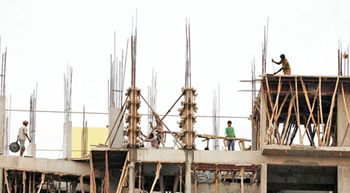Housing for all by 2022 is likely to face a large number of challenges in implementation. However, even if it is only partially implemented, it will offer tremendous opportunities for suppliers of building materials.
The Pradhan Mantri Awas Yojana (PMAY) or Housing for All by 2022, launched on the 25th of June 2015, is a highly ambitious programme. As the name suggests, the programme aims to provide a house to every Indian by 2022, i.e., in the next seven years. More specifically, the scheme will target women (irrespective of their caste), poor people, and those belonging to economically weaker section (EWS), lower income groups (LIG), scheduled tribes (ST) and scheduled castes (SC) in the urban areas of India. Towards this purpose, Housing for All aims to construct more than 2 crore houses across 500 cities by 2022.
Housing for All will be executed through a three-phase implementation plan as follows:
- Phase I from April 2015 to March 2017, with a total of 100 cities witnessing developmental work started and completed
- Phase II from April 2017 to March 2019, with a total of 200 more cities witnessing developmental work started and completed
- Phase III from April 2019 to March 2022, covering the remaining 200 cities
Implementation challenges
Implementation of the programme is, however, likely to face many hurdles.
- Speed of urban infrastructure: Development of urban infrastructure may not keep pace with the growing urban population, leading to a shortfall in provision of basic amenities like water, sewerage, power and public transport, among others (all of which are essential for housing development).
- Access to finance: Banks are unwilling to lend to the real estate sector and do so only at high interest rates, thus affecting the viability of projects.
- Haphazard urban planning: Since planning the growth of cities is virtually non-existent in India, availability of land for housing development is scarce.
- Maze-like planning process: A large number of approvals are required for housing projects and these take a long time in coming. Longer timelines raise the cost of construction and reduce the circulation of capital.
- High construction cost: Rising input costs and indirect taxes like stamp duty, VAT, etc., raise the cost of construction and put a strain on the viability or profitability of projects, and also reduce the affordability of houses for target buyers.
- Out-of-date regulations: Archaic norms for floor area ratio (FAR), floor space index (FSI), ground coverage, parking provision, etc., have led to horizontal expansion of housing and inefficient usage of the limited available land.
- Cost overruns caused by delays: Projects require several more regulatory approvals even as the construction is ongoing. These may lead to further slowing down of work.
- Technology & skill-related industry concerns: The construction industry in India suffers from several other concerns such as shortage of skilled workers and lack of technology leading to longer lead times for housing construction.
Green-shoots
Despite these challenges, progress on Housing for All is definitely visible.
- Chhattisgarh has approved India´s first affordable housing project under the scheme. The approved project comprises a total of 26,034 houses in 11 towns and cities; out of which 12,670 units have been allocated to EWS, with the remaining for LIG category.
- Under the scheme, Haryana has approved 11,259 flats for the EWS category. The flats will be constructed at Jagadhari (1,179), Karnal (924), Hisar (3,330), Fatehabad (4,928), Safidon (498) and Agroha (400).
- The Ministry of HUPA has received the Draft Housing Policy of Andhra Pradesh, and this draft proposes several waivers like building plan approval fee, infrastructure development charges, land con¡version fee, registration fee as well as betterment charges for boosting affordable housing which will benefit the LIG and EWS categories. Besides these, a relaxation of the floor area ratio (FAR) has also been proposed.
- The state of Telangana has also proposed similar measures along with the proposal that the houses/flats be constructed by state agencies on a rental-cum-ownership basis. This would also lead to the adoption of new initiatives like ´Rent Cum Ownership´ and ´Equity Building´, especially for the low-income segment.
- Nagaland state will provide 4,300 affordable houses in Dimapur under the ´Housing for All by 2022´ scheme.
- The Jan Awas Yojna has been launched by the Rajasthan government as part of the national scheme. Under the scheme, the government aims to construct houses in cities with more than 1 lakh population. There are 13 such cities in the state.
The overall target of 2 crore houses under ´Housing for All´ programme seems unlikely to be fulfilled given the challenges. But on the business front, even if only 30 per cent of the target is achieved, the opportunities for suppliers of building materials are tremendous.
This article has been authored by Sa´ad Shaikh, who is a team lead, and Rohit Bhamburkar, who is a senior research analyst at ValueNotes Strategic Intelligence, a firm that specializes in the management of competitive and market intelligence, information and research.



Leave a Reply
You must be logged in to post a comment.